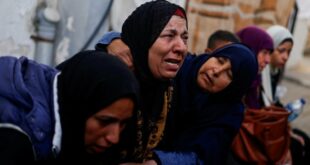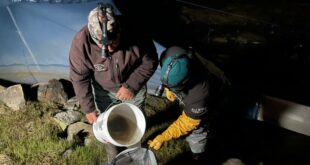Atefeh Khademolreza's new short film amplifies the voices of minorities in Iran

One year after the death of Mahsa Amini, artists in Canada and around the world are helping to keep the plight of Iranian women and minorities alive.
The 22-year-old Kurdish woman was arrested by Iran's morality police in Tehran on Sept. 13, 2022, for allegedly wearing her hijab improperly. She fell into a coma after being taken to a detention centre and died three days later.
- Demonstrators in Canadian cities call for change in Iran after Mahsa Amini's death
- Iranian rapper to be jailed for 6 years, avoiding death sentence, lawyer says
Amini's death sparked massive protests in Iran demanding an end to theIslamic Republic's strict dress code. It spurred international demonstrations calling for greater freedoms for women and minorities. And it is turning up in the works of musicians, storytellers, filmmakers and more who are using their mediums to keep the story alive.
"Witnessing how people in Iran stood up for their rights inspired me to be an activist and tell and share my personal stories as a filmmaker to the world," said Atefeh Khademolreza, an Iranian-Canadian filmmaker who now lives in Toronto.
"I wanted to be part of this movement … amplifying the voice of women in Iran and also the LGBTQ+ people,"
I learned from the 'Woman, Life, Freedom movement that achieving freedom comes with a price.
– Atefeh Khademolreza, Canadian-Iranian filmmaker
Khademolreza's short film Meteor, which screened at the 2023 Toronto International Film Festival (TIFF), explores the mysterious death of her gay best friend in Iran.
"It's about how difficult it is to be yourself in a country like Iran. And it's about sadness but at the same time hope," she said.
Khademolreza said there is a personal sacrifice to having made the film. She cannot return to Iran out of fear of retaliation by the country's regime.
"I learned from the 'Woman, Life, Freedom' movement that achieving freedom comes with a price," she said.
'My voice is my weapon'
Iranian singer Faravaz Farvardin uses her music to advocate for women's rights from afar.
Originally from Tehran, she came to Germany for a performance in 2018 and now calls the country home as political refugee.
"I just cannot see the pain of other people and be silent," said Farvardin who faces a one-year sentence in Iran for her music. "My voice is my weapon and I'm using it."

- I was afraid to criticize the Iranian regime in my films — until my friend's mysterious death
- 'Don't let the protests fade away': The Iranian-Canadian artists showing solidarity with women in Iran
To mark the anniversary of Amini's death, the 33-year-old singer has released a new song titled Ey Iran, which gives a voice to the oppressed in Iran and encourages resistance, she said.
"My hope for my country is 'Woman, Life, Freedom.' I think that slogan has everything," she said. "A country where women are free and safe, life is going on and freedom is happening."
The price of protest
Artists and women in Iran have expressed dissent in various ways: singing in public, burning hijabs, cutting their hair and spraying resistance slogans in graffiti.
For some, those acts of defiance have come at a huge cost.
Prominent Iranian rapper Toomaj Salehi, who heavily criticized the Islamic Republic through his lyrics, was convicted in July of "corruption on Earth," one of the country's most serious offences. He was spared the death sentence but still ordered to six years in jail.
He is not alone.

Nearly 20,000 people have been arrested during protests, according to Human Rights Activists in Iran. The group, which closely tracks Iran's crackdown, states that at least 527 people have also been killed in demonstrations.
Persis Karim, director of the Center for Iranian Diaspora Studies at San Francisco State University, said artists are still taking great risks to defy Iran's regime to press for freedom.
"It's not new to Iranians. They used art in the 1979 revolution. They used performance. They used music to rally people in the act of transforming their society," she said.
"Art, both in the visual sense, but also music … and performance art as well have been essential in keeping the struggle going, but also creating opportunities for people outside of Iran to understand the stakes in this protest movement."
Karim believes artists have helped keep a necessary spotlight on developments in Iran as the gaze of the global media has faded.
"Murals appeared all over the country in the United States where people wanted to highlight the significance of the Woman Life Freedom movement as a woman-led revolutionary protest movement," she said.
"This is a moment where a global solidarity around the struggle for women's rights and human rights is absolutely essential."
*****
Credit belongs to : www.cbc.ca
 MaharlikaNews | Canada Leading Online Filipino Newspaper Portal The No. 1 most engaged information website for Filipino – Canadian in Canada. MaharlikaNews.com received almost a quarter a million visitors in 2020.
MaharlikaNews | Canada Leading Online Filipino Newspaper Portal The No. 1 most engaged information website for Filipino – Canadian in Canada. MaharlikaNews.com received almost a quarter a million visitors in 2020.








